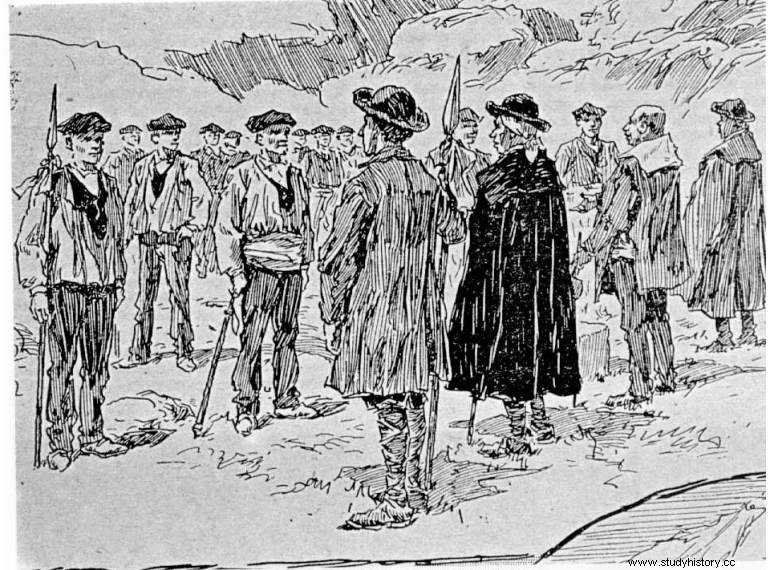The border milestone between Spain and France nº 262, between the Navarran valley of Roncal and the French valley of Baretous, has witnessed every July 13 since 1375 the ceremony of the Tribute of the Three Cows . With it, the letter of peace or “facería is fulfilled. ” (agreement to resolve a conflict over pasture between municipalities) that was issued in Ansó (Huesca) in 1375 to resolve the disputes between these valleys, and which represents the oldest international treaty currently in force in all of Europe.
In reality, the origin of the tribute and the ceremony seems to be even earlier than that date, and unknown, but the conflict that gave rise to the Treaty as it has survived to this day occurred in 1373, when the Roncalese Pedro Karrika assassinated the Baretonese Pierre Sansoleren in a dispute over sources and pastures for his herds in border territory. And blood called for blood:Pedro Karrika and 25 other Roncales died when they were ambushed on their way back from killing Pierre Sansoler's family in retaliation for the violent death of Karrika's family at French hands. These brawls and revenge culminated in the battle of Aguincea , in which the towns of Isaba, Uztarroz, Urzainki and Garde intervened on behalf of Roncal, and where 53 Navarrese and 200 French perished.

Given the turn that events were taking and the failure in the search for a solution by King Carlos II of Navarra and Viscount Gaston III de Foix–Bearne , both parties agreed to request the mediation of “six good men ” of the town of Ansó, Aragonese and a neighbor of the aforementioned towns of Roncal, led by its mayor Sancho Gracia . Although it may seem strange that another town on the southern side of the Pyrenean mountain range was chosen as arbitrator, the truth is that relations between neighboring Pyrenean valleys have never understood political borders, but rather those marked by nature itself. Thus, knowing better the customs and uses of the territories involved, they had no doubt that the resolution adopted would be much more fair and effective than any other that came from distant courts.

Finally, in the atrium of the church of San Pedro de Ansó, on October 16, 1375, the sentence was passed by which the Baretous valley (where the town of Aramitz is located and from which the famous musketeer took its name) should compensate the Roncal Valley every July 13 with three two-year-old cows “sine macula ” and of the same “hornage, fur and teeth ”. The ruling was well received by the parties, since since that distant 1375 there were no more clashes between the Valley of Roncal and Baretous. Since then, and overcoming conflicts and wars between Spain and France that took place in subsequent centuries, the Tribute of the Three Cows It has been paid to date as agreed. A key moment in its survival occurred in 1856, when the Treaty of Limits between Spain and France was signed, delimiting the current border between the two countries, repealing all previous border legislation. All? No, the Tribute of the Three Cows is included in annex four of said regulation, once again overcoming the vicissitudes of time and the new relations between countries.
The actual ceremony is very simple and brief. At the Ernaz pass , every July 13, after reviewing the cattle by the Isaba veterinarian, the French mayors and those of Uztarroz, Urzainki and Garde, dressed in their traditional costumes, alternately place one hand over the other on top of the border marker of the Pierre de St. Martin , being the mayor of Isaba the one who places his hand on those of the others and repeats aloud three times the Latin expression Pax avant (peace onwards). The mayor of Ansó, on his part, supervises the correct fulfillment of what his ancestors agreed upon. The fate of the cows was also stipulated:two are for the town of Isaba and the third is distributed on a rotating basis each year between Uztarroz, Urzainki, Garde and the rest of the towns that took part in the battle of Aguincea.

Today, the day is, above all, a festival of cross-border friendship between neighboring towns, with folklore samples from both territories, far removed from the events that originated it. The Government of Navarra declared the Tribute of the Three Cows an Asset of Intangible Cultural Interest on January 24, 2011 and, as a curiosity, this year 2015 will be held the day immediately before a stage of the high mountain Tour de France ends precisely there, at the Pierre de St. Martin.
Collaboration Miguel Ángel Aznárez Murillo
